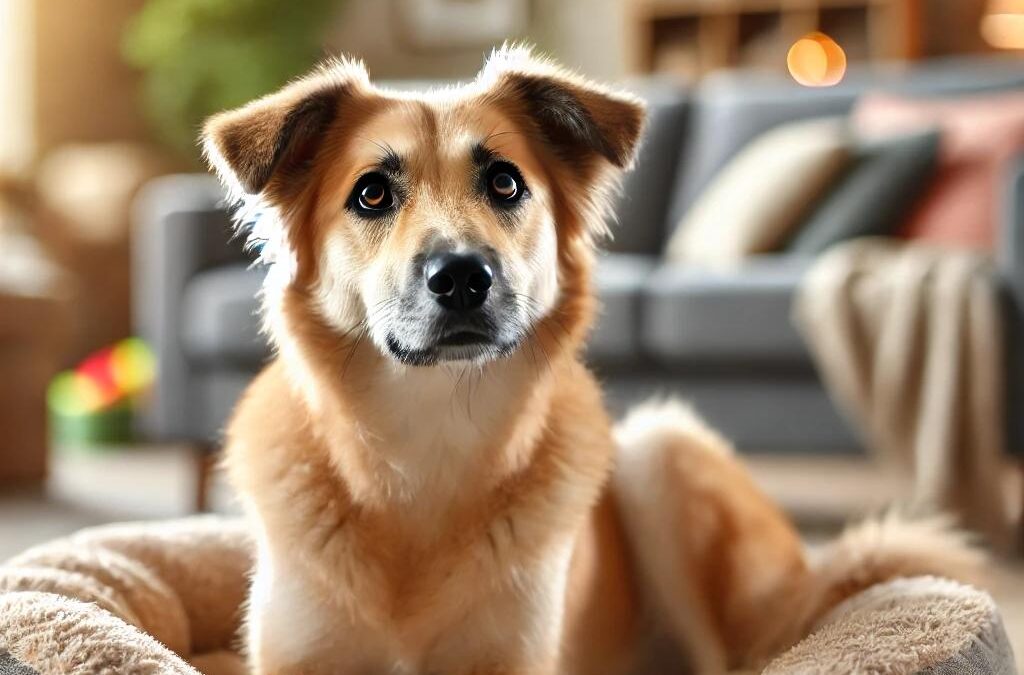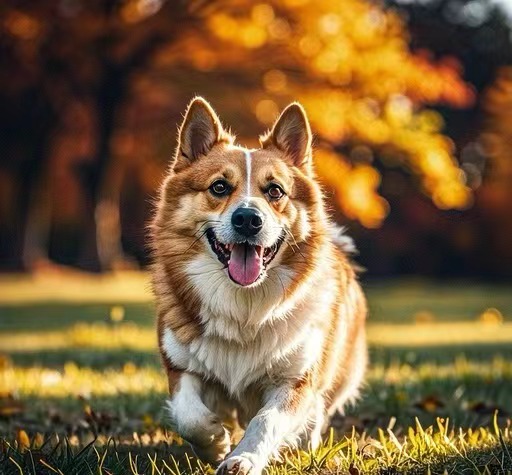
deur TCMVET | okt 15, 2024 | Onderzoek en nieuws
Acral lick granuloma, also known as acral lick dermatitis, is a common skin condition in dogs caused by excessive licking of a specific area. Typically found on the lower part of the legs, this self-induced skin lesion can lead to chronic issues if not addressed early. In this article, we’ll explore the causes, symptoms, and treatment options for acral lick granulomas, helping pet owners identify and manage this condition before it becomes a long-term problem.
What Is an Acral Lick Granuloma?
An acral lick granuloma is a skin lesion that forms due to repetitive licking of a specific area, usually the lower legs. The most commonly affected areas are the wrist (carpal joint) of the front limbs and the hock (ankle) of the back legs. Over time, the constant licking causes hair loss, redness, inflammation, and thickened skin, which can eventually lead to infection if left untreated.
Causes of Acral Lick Granulomas
Several factors can contribute to a dog’s excessive licking, leading to the formation of a granuloma. These include:
- allergieën
Allergies to food, environmental factors, or fleas can cause itchiness, prompting a dog to lick a specific area to relieve discomfort.
- Infections
Fungal, bacterial, or parasitic infections can make a dog’s skin irritated, leading to persistent licking.
- Pijn
Underlying joint or bone pain, such as arthritis, may cause a dog to lick the affected area in an attempt to soothe the discomfort.
- Behavioral Issues
Stress, anxiety, or boredom can result in compulsive behaviors, including repetitive licking, which eventually leads to the formation of a granuloma.
- Neurological Issues
In some cases, nerve damage or other neurological problems can trigger excessive licking.
Symptoms of Acral Lick Granulomas
Acral lick granulomas are typically easy to spot. Some of the most common symptoms include:
- Hair loss at the licking site
- Red, inflamed skin
- Thickened or hardened skin at the affected area
- Open sores or ulcers that may become infected
- Frequent licking or chewing of the same spot
If you notice any of these signs, it’s important to consult your veterinarian for diagnosis and treatment.
Treatment Options for Acral Lick Granulomas
- Onderliggende oorzaken aanpakken
The first step in treating acral lick granulomas is to identify and address the underlying cause of the licking. This may involve treating allergies, infections, or joint pain, depending on the root of the problem. Your veterinarian may prescribe antibiotics for infections, antihistamines for allergies, or pain relievers if arthritis or another pain-related issue is present.
- Behavioral Modification
If anxiety or boredom is contributing to the excessive licking, behavioral modification may be necessary. Increasing exercise, mental stimulation, and reducing stress through environmental changes can help reduce compulsive licking. Your veterinarian may also recommend anti-anxiety medications or supplements if needed.
- Topical Medications
Topical treatments, such as medicated creams or sprays, can help soothe the skin and promote healing. Some products also contain ingredients to deter the dog from licking the area further.
- Bandaging or E-Collar Use
In some cases, bandaging the affected area or using an e-collar (Elizabethan collar) can prevent further licking, giving the skin time to heal.
- Laser Therapy or Surgery
In severe or chronic cases, laser therapy or surgical removal of the granuloma may be necessary to promote healing. These treatments are typically reserved for cases that do not respond to more conservative methods.
Preventing Acral Lick Granulomas
Preventing acral lick granulomas involves addressing the potential causes of the behavior before it becomes a problem. Regular vet check-ups, maintaining a stimulating environment, and treating underlying medical issues early can reduce the likelihood of your dog developing this condition.
Acral lick granulomas are a challenging condition to treat, especially if they become chronic. Early intervention is key to preventing long-term complications, so it’s important to seek veterinary care as soon as you notice excessive licking or the development of a skin lesion. With the right combination of medical treatment, behavioral modification, and preventive care, your dog can recover and avoid further issues.

deur TCMVET | okt 10, 2024 | Onderzoek en nieuws
Pinched nerves can be a serious issue for dogs, leading to discomfort and mobility problems. While the term might sound alarming, understanding what it entails is essential for every dog owner. Unlike humans, where a pinched nerve usually involves compression of the nerve root, dogs experience similar symptoms due to pressure on the spinal cord itself. Here’s a closer look at what causes this condition, how to identify it, and the best ways to manage it.
Understanding the Mechanics of a Pinched Nerve
A pinched nerve in dogs often results from something pressing on the spinal cord. The spinal cord is protected by the vertebrae, and between each vertebra are intervertebral discs that cushion the bones and allow for movement. When these discs bulge or rupture, they can compress the spinal cord, leading to pain and other neurological symptoms.
While intervertebral disc disease is the most common cause of a pinched nerve in dogs, other factors such as tumors or blood clots affecting the spinal cord can also contribute, although these instances are rare.
Symptomen waar u op moet letten
Recognizing the signs of a pinched nerve in your dog is crucial for prompt treatment. Common symptoms include:
- Pain or Discomfort: Your dog may exhibit signs of pain such as whining, yelping, or being reluctant to move.
- Zwakheid: You might notice your dog struggling to walk or jumping.
- Impaired Coordination: Difficulty maintaining balance or wobbly movements can indicate nerve issues.
- Gedragsveranderingen: If your normally active dog becomes lethargic or irritable, it may be a sign of pain.
Diagnose en behandelingsopties
If you suspect your dog has a pinched nerve, it’s important to seek veterinary care as soon as possible. A veterinarian will perform a thorough examination and may recommend diagnostic tests like X-rays or MRIs to determine the exact cause of the symptoms.
Treatment options typically include:
- Medicatie: Your vet may prescribe anti-inflammatory drugs or pain relief medications to manage your dog’s discomfort.
- Rest and Activity Limitation: Reducing your dog’s activity can help alleviate pressure on the spinal cord and promote healing.
- Fysiotherapie: Engaging in rehabilitation exercises can improve mobility and strengthen the muscles surrounding the spine.
- Chirurgische ingreep: In severe cases where conservative treatments are ineffective, surgery may be necessary to relieve pressure on the spinal cord.
Preventieve maatregelen
While not all cases of pinched nerves can be prevented, there are steps you can take to reduce your dog’s risk:
- Zorg voor een gezond gewicht: Keeping your dog at a healthy weight can lessen the strain on their spine.
- Ensure Proper Nutrition: A balanced diet with adequate nutrients can support overall spinal health.
- Provide Safe Play Environments: Avoid high-impact activities that could lead to injuries, particularly in older dogs or those with pre-existing conditions.
Understanding pinched nerves in dogs is essential for any responsible pet owner. By being aware of the symptoms, seeking timely veterinary care, and implementing preventive measures, you can help ensure your dog remains healthy and active. If you notice any signs of discomfort in your dog, don’t hesitate to reach out to your veterinarian for guidance and support.

deur TCMVET | 17 augustus 2024 | Onderzoek en nieuws
Stress in pets is often overlooked, but it can have significant impacts on their health and behavior. Just like humans, pets can experience stress due to various factors such as changes in their environment, loud noises, or separation from their owners. Understanding how stress affects your pet and how to manage it is crucial for ensuring their overall well-being. In this article, we’ll explore the common causes of stress in pets, the effects it can have on their health, and ways to reduce stress to keep your pet happy and healthy.
1. Common Causes of Stress in Pets
Pets can experience stress due to a variety of reasons, and it’s important to recognize the signs early.
- Environmental Changes: Moving to a new home, rearranging furniture, or introducing a new pet can be unsettling for your pet and lead to stress.
- Separation Anxiety: Pets, especially dogs, can become anxious when left alone for extended periods, leading to destructive behaviors.
- Loud Noises: Thunderstorms, fireworks, and other loud noises can trigger fear and anxiety in pets, causing them to hide or display signs of distress.
- Lack of Routine: Pets thrive on routine, and disruptions to their regular schedule, such as irregular feeding times or changes in exercise habits, can lead to stress.
2. Effects of Stress on Pet Health
Chronic stress can have serious consequences for your pet’s physical and mental health.
- Behavioral Changes: Stress can lead to increased aggression, excessive barking, destructive chewing, or inappropriate elimination. These behaviors are often a pet’s way of coping with anxiety.
- Digestive Issues: Stress can disrupt your pet’s digestive system, leading to symptoms such as vomiting, diarrhea, or loss of appetite.
- Weakened Immune System: Prolonged stress can weaken your pet’s immune system, making them more susceptible to infections and illnesses.
- Skin Problems: Pets may develop skin issues like excessive scratching, licking, or hair loss due to stress-induced conditions such as dermatitis or hot spots.
3. How to Reduce Stress in Pets
Managing your pet’s stress is essential for their overall well-being. Here are some effective strategies:
- Maintain a Consistent Routine: Keeping a regular schedule for feeding, walks, and playtime can provide a sense of security and reduce anxiety in pets.
- Provide a Safe Space: Ensure your pet has a quiet, comfortable place where they can retreat when feeling overwhelmed. This can be a designated room, a cozy bed, or a crate.
- Use Calming Aids: Natural calming supplements such as chamomile, valerian root, or CBD oil can help reduce anxiety in pets. Additionally, pheromone diffusers or calming sprays can create a more relaxing environment.
- Increase Physical and Mental Stimulation: Regular exercise and mental stimulation, such as puzzle toys or interactive play, can help reduce stress by keeping your pet engaged and tired out.
- Socialization and Positive Reinforcement: Gradually introducing your pet to new experiences, people, and other animals can help reduce anxiety. Use positive reinforcement to encourage calm behavior during stressful situations.
Stress in pets can have a profound impact on their health and behavior, but with the right strategies, it’s possible to manage and reduce it. By maintaining a consistent routine, providing a safe and calm environment, and using natural calming aids, you can help your pet cope with stress and lead a happier, healthier life. Always consult your veterinarian if you notice signs of stress in your pet, as they can provide additional guidance and support.

deur TCMVET | 17 juli 2024 | Onderzoek en nieuws
Als toegewijde huisdiereneigenaar is het begrijpen van de verschillende soorten cysten die van invloed kunnen zijn op uw hond cruciaal voor zijn gezondheid en welzijn. Cysten bij honden kunnen variëren in grootte, uiterlijk en ernst, en weten hoe u ze kunt identificeren en behandelen is essentieel om ervoor te zorgen dat uw harige vriend gezond blijft. In dit artikel zullen we de verschillende soorten hondencysten, hun oorzaken, symptomen en effectieve behandelingsopties onderzoeken.
Hondcysten begrijpen
Cysten zijn zakachtige weefselzakjes die gevuld kunnen worden met vloeistof, lucht of andere stoffen. Hoewel veel cysten goedaardig zijn, hebben sommige mogelijk medische aandacht nodig. Hier zijn de meest voorkomende soorten cysten bij honden:
- Talgcysten
- Beschrijving: Deze cysten ontstaan wanneer de talgklieren verstopt raken, wat leidt tot een ophoping van talg.
- Verschijning: Ze zien er vaak uit als kleine, verhoogde knobbeltjes die wit of lichtblauw van kleur kunnen zijn.
- Behandeling: In veel gevallen behoeven talgcysten geen behandeling en kunnen ze vanzelf verdwijnen. Als ze echter geïnfecteerd raken of ongemak veroorzaken, kan chirurgische verwijdering noodzakelijk zijn.
- Folliculaire cysten
- Beschrijving: Folliculaire cysten ontwikkelen zich uit haarzakjes en worden vaak aangetroffen in gebieden met dichte vacht.
- Verschijning: Deze cysten kunnen in grootte variëren en kunnen scheuren, waardoor afscheiding ontstaat.
- Behandeling: Behandelingsopties omvatten chirurgische verwijdering en antibiotica als er een infectie is.
- Dermoid cysten
- Beschrijving: Dermoïdcysten zijn aangeboren en bevatten huid- en haarzakjes.
- Verschijning: Ze zijn meestal stevig en bevinden zich langs de wervelkolom.
- Behandeling: Chirurgische verwijdering wordt doorgaans aanbevolen om complicaties te voorkomen.
- Epidermoïde cysten
- Beschrijving: Deze cysten ontstaan uit de buitenste huidlaag en zijn gevuld met keratine.
- Verschijning: Ze zien eruit als kleine, ronde bultjes en kunnen in de loop van de tijd langzaam groeien.
- Behandeling: Chirurgische verwijdering is vaak de beste handelwijze.
Symptomen van hondencysten
Hoewel het uiterlijk van cysten kan variëren, zijn veel voorkomende symptomen:
- Zwelling of knobbeltjes onder de huid
- Roodheid of ontsteking
- Afscheiding of bloeding
- Pain or discomfort
- Veranderingen in gedrag of eetlust
Als u een van deze symptomen opmerkt, is het essentieel om uw dierenarts te raadplegen voor een juiste diagnose.
Diagnose van hondencysten
De diagnose omvat doorgaans een lichamelijk onderzoek en kan het volgende omvatten:
- Fijne naaldaspiratie (FNA): Een klein monster van de inhoud van de cyste wordt geëxtraheerd en onder een microscoop onderzocht.
- Biopsie: Er wordt een weefselmonster genomen voor verdere analyse om het type cyste te bepalen.
- In beeld brengen: Er kunnen röntgenfoto's of echo's worden gebruikt om de grootte en locatie van de cyste te bepalen.
Hondencysten behandelen
Het behandelplan voor hondencysten is afhankelijk van het type en de ernst van de cyste. Veel voorkomende behandelingsopties zijn onder meer:
- Observatie: Kleine, goedaardige cysten vereisen mogelijk geen onmiddellijke behandeling en kunnen op veranderingen worden gecontroleerd.
- Chirurgisch verwijderen: Dit wordt vaak aanbevolen voor grotere cysten, geïnfecteerde cysten of cysten die ongemak veroorzaken.
- Medicatie: Antibiotica kunnen worden voorgeschreven als er sprake is van een infectie, en pijnstillers kunnen het ongemak helpen beheersen.
Voorkomen van hondencysten
Hoewel niet alle cysten kunnen worden voorkomen, kan het handhaven van de algehele gezondheid van uw hond het risico verminderen. Regelmatige verzorging, een uitgebalanceerd dieet en routinematige veterinaire controles zijn essentieel voor vroege detectie en preventie.
Het begrijpen van de verschillende soorten cysten die uw hond kunnen beïnvloeden, is van vitaal belang voor zijn gezondheid en welzijn. Door de symptomen te herkennen en een passende behandeling te zoeken, kunt u ervoor zorgen dat uw harige vriend gelukkig en gezond blijft. Raadpleeg altijd uw dierenarts voor de beste handelwijze voor de specifieke behoeften van uw hond. Blijf op de hoogte en proactief om de beste zorg te bieden aan uw trouwe metgezel.

deur TCMVET | 22 juni 2024 | Onderzoek en nieuws
Invoering
Kanker is een angstaanjagend woord voor elke huisdiereneigenaar. Het vroegtijdig begrijpen en herkennen van symptomen, samen met het nemen van passende behandelingsmaatregelen, kan de overlevingskansen van een hond echter aanzienlijk verbeteren. Dit artikel biedt een uitgebreide overlevingsgids voor hondenkanker om u te helpen beter voor uw geliefde huisdier te zorgen.
Veel voorkomende soorten hondenkanker begrijpen
Het kennen van de meest voorkomende soorten kanker bij honden is cruciaal voor vroege detectie en behandeling. Hier zijn enkele veel voorkomende soorten hondenkanker:
- lymfoom: Beïnvloedt de lymfeklieren en het lymfestelsel.
- Osteosarcoom: De meest voorkomende botkanker, vaak aangetroffen bij grote rassen.
- Huidkanker: Inclusief melanoom, plaveiselcelcarcinoom en andere.
- Borstkliertumoren: Vooral vaak voorkomend bij niet-gesteriliseerde vrouwelijke honden.
Vroege herkenning van symptomen
Het vroegtijdig herkennen van kankersymptomen kan het succespercentage van de behandeling aanzienlijk verbeteren. Let op de volgende tekenen:
- Onverklaarbare knobbels of zwelling: Eventuele ongewone knobbeltjes moeten door een dierenarts worden gecontroleerd.
- Verlies van eetlust: Plotselinge desinteresse in voedsel kan een vroeg waarschuwingssignaal zijn.
- Gewichtsverlies: Onverklaarbaar gewichtsverlies is een reden tot bezorgdheid.
- Aanhoudende hoest- of ademhalingsproblemen: Vooral als het verergert bij activiteit.
Diagnose en behandelingsopties
Diagnose
Het diagnosticeren van kanker omvat een reeks tests, waaronder:
- Röntgenfoto's en echo's: Om te controleren op interne orgaan- en botafwijkingen.
- Fijne naaldaspiratie of biopsie: Om een monster te analyseren en het kankertype te bevestigen.
- Blood Tests: Om de algehele gezondheid van de hond te beoordelen.
Behandelingsopties
Behandelplannen variëren op basis van het type kanker en de progressie. Veel voorkomende behandelingen zijn onder meer:
- Chirurgie: Directe verwijdering van de tumor.
- Chemotherapie: Medicijnen gebruiken om de verspreiding van kankercellen onder controle te houden.
- Bestralingstherapie: Hoogenergetische stralen om kankercellen te doden.
- Immunotherapie: Verbetering van het immuunsysteem van de hond om kanker te bestrijden.
Dagelijkse verzorging en ondersteuning
Dieet en voeding
- High-Protein Diet: Helpt de spiermassa te behouden.
- Antioxidanten: Vitaminen C en E kunnen schade door vrije radicalen helpen bestrijden.
- Omega-3 vetzuren: Hebben ontstekingsremmende eigenschappen die de progressie van kanker kunnen vertragen.
Regelmatige controles
Regelmatige veterinaire controles zijn essentieel voor een vroege detectie en het indien nodig aanpassen van behandelplannen.
Emotionele steun
Ook de geestelijke gezondheid van een hond is belangrijk. Zorg ervoor dat uw hond voldoende gezelschap en passende activiteiten heeft om een positieve instelling te behouden.
Conclusie
Als je te maken krijgt met hondenkanker, is het belangrijk om positief en kalm te blijven. Door veel voorkomende soorten kanker te begrijpen, symptomen vroegtijdig te herkennen, tijdige diagnose en behandeling te zoeken en uitgebreide dagelijkse zorg en emotionele steun te bieden, kunt u de overlevingskansen van uw hond aanzienlijk verbeteren. We hopen dat deze overlevingsgids voor hondenkanker u en uw geliefde huisdier helpt.
Met dit artikel willen we eigenaren van gezelschapsdieren voorzien van een gedetailleerde overlevingsgids voor hondenkanker, zodat ze de kankerproblemen van hun hond beter kunnen begrijpen en ermee om kunnen gaan. Als u vragen heeft of verdere ondersteuning nodig heeft, kunt u een dierenarts raadplegen.
(Trefwoorden: overlevingsgids voor hondenkanker, soorten hondenkanker, symptomen van hondenkanker, behandeling van hondenkanker, zorg voor hondenkanker)
4o

deur TCMVET | jun 5, 2024 | Onderzoek en nieuws
Watching a beloved pet suffer from a serious illness like lymphoma can be one of the most challenging experiences for any dog owner. Understanding the signs that indicate your dog is reaching the end stages of this disease can help you provide the best possible care and comfort during their final days. In this article, we will discuss the key signs that your dog may be dying from Stage 4 lymphoma and how you can support them through this difficult time.
What Is Stage 4 Lymphoma in Dogs?
Lymphoma is a type of cancer that affects the lymphatic system, which is a crucial part of the immune system. Stage 4 lymphoma indicates that the cancer has progressed significantly and has likely spread to other organs beyond the lymph nodes, such as the liver, spleen, and bone marrow.
Key Signs Your Dog Is Dying from Stage 4 Lymphoma
1. Severe Weight Loss
One of the most noticeable signs of advanced lymphoma is severe weight loss. Despite eating, your dog may continue to lose weight rapidly due to the cancer’s impact on their body’s ability to absorb nutrients.
2. Loss of Appetite
Dogs with Stage 4 lymphoma often lose interest in food. This can be due to nausea, pain, or the body’s declining function. Encouraging your dog to eat small, palatable meals can sometimes help, but they may still refuse food.
3. Extreme Fatigue and Weakness
As the disease progresses, your dog may become extremely tired and weak. They might struggle to get up, walk, or engage in activities they once enjoyed. This fatigue is a result of the cancer spreading and the body’s declining energy levels.
4. Breathing Difficulties
Breathing difficulties are common in dogs with advanced lymphoma, especially if the cancer has spread to the chest area. You may notice labored or rapid breathing, coughing, or an increased effort to breathe.
5. Swollen Lymph Nodes
Swollen lymph nodes are a primary symptom of lymphoma, but in Stage 4, these nodes can become very large and hard. You might notice these enlarged nodes under your dog’s jaw, behind the knees, or in the groin area.
6. Pale Gums and Mucous Membranes
Pale gums and mucous membranes can indicate anemia, which is common in dogs with late-stage lymphoma. This occurs because the cancer affects the body’s ability to produce healthy red blood cells.
7. Increased Thirst and Urination
Some dogs with Stage 4 lymphoma may show increased thirst and urination. This can be a result of the cancer affecting the kidneys or other metabolic processes in the body.
Providing Comfort and Care
While there is no cure for Stage 4 lymphoma, there are ways to make your dog’s remaining time as comfortable as possible:
- Pijnbeheersing: Consult your veterinarian about pain relief options to ensure your dog is not suffering unnecessarily.
- Hydratatie: Keep your dog hydrated by offering water regularly. If they refuse to drink, discuss alternative hydration methods with your vet.
- Comfortable Environment: Create a comfortable resting area for your dog, with soft bedding and easy access to food and water.
- Emotionele steun: Spend quality time with your dog, offering affection and companionship. Your presence can provide great comfort during this difficult time.
Conclusie
Recognizing the signs that your dog is dying from Stage 4 lymphoma is crucial for providing appropriate care and comfort. By understanding these symptoms and working closely with your veterinarian, you can ensure that your dog’s final days are as peaceful and pain-free as possible. Cherish the moments you have left with your furry friend, and provide them with the love and care they deserve.







